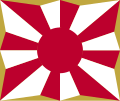Fail:Flag of the Japan Self-Defense Forces.svg

Saiz pratonton PNG bagi fail SVG ini: 714 × 599 piksel . resolusi suai: 286 × 240 piksel | 572 × 480 piksel | 915 × 768 piksel | 1,220 × 1,024 piksel | 2,440 × 2,048 piksel | 1,089 × 914 piksel.
Fail sandad (Pail SVG, tipong tuou 1,089 × 914 piksol, ginayo pail: 1 KB)
Sajara fail
Todoso id kalindo / maso do mongintong di upa dilo fail ontok di timpu nokomoi.
| Tadauwulan/Maso | Sinondulu | Ginayo | Moomomoguno | Komi | |
|---|---|---|---|---|---|
| timpu diti | 14:47, 3 Milau 2022 |  | 1,089 × 914 (1 KB) | TKsdik8900 | Simplified the code |
| 02:55, 20 Milatok 2010 |  | 1,089 × 914 (2 KB) | Zscout370 | Cloning and colors | |
| 02:49, 20 Milatok 2010 |  | 1,089 × 914 (3 KB) | Zscout370 | Fixing, cloning | |
| 06:56, 27 Mahas 2007 |  | 1,089 × 914 (3 KB) | Zscout370 | Revamping of the image. | |
| 20:09, 15 Ngiop 2006 |  | 1,089 × 914 (2 KB) | Brevam | {{Information |Description = *{{ja|自衛隊旗}} *{{en|Flag of Japan Self-Defense Forces (JSDF)}} |Source = Created by ~~~ |Date = April 15, 2006 |Author = ~~~ |Permission = Public Domain. According to the copyright laws of Japan, the design of this flag |
Pomogunaan do fail
Iti kiharo bolikon poingoput id pail diti:
Pomogunaan fail sompomogunan
Fail diti ginuna do wiki suai:
- Kopomogunaan id af.wikipedia.org
- Kopomogunaan id ang.wikipedia.org
- Kopomogunaan id ar.wikipedia.org
- Kopomogunaan id arz.wikipedia.org
- Kopomogunaan id ast.wikipedia.org
- Kopomogunaan id azb.wikipedia.org
- Kopomogunaan id az.wikipedia.org
- Kopomogunaan id ban.wikipedia.org
- Kopomogunaan id bcl.wikipedia.org
- Kopomogunaan id bg.wikipedia.org
- Kopomogunaan id bjn.wikipedia.org
- Kopomogunaan id blk.wikipedia.org
- Kopomogunaan id bn.wikipedia.org
- Kopomogunaan id br.wikipedia.org
- Kopomogunaan id bs.wikipedia.org
- Kopomogunaan id ca.wikipedia.org
- Kopomogunaan id cdo.wikipedia.org
- Kopomogunaan id ckb.wikipedia.org
- Kopomogunaan id cs.wikipedia.org
- Kopomogunaan id dag.wikipedia.org
- Kopomogunaan id da.wikipedia.org
- Kopomogunaan id de.wikipedia.org
Intangai lobi momomoguno sompomogunan do pail diti



